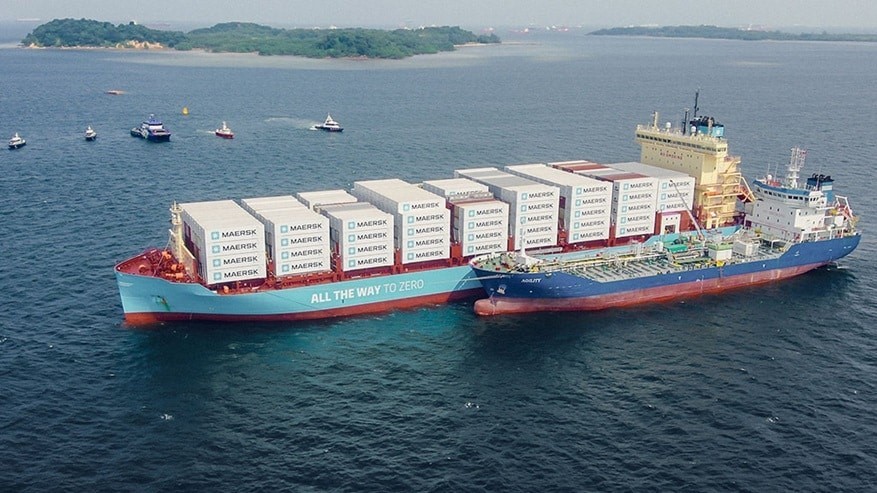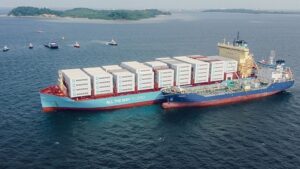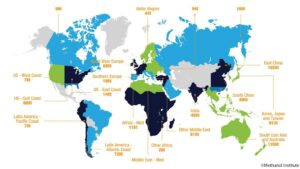Photo of Laura Maersk Methanol Bunkering in Singapore is courtesey of Maersk
“In interviews with Nordic ports regarding their views on barriers against supplying zero-carbon fuels, nearly all reported safety and regulatory issues as key barriers against supplying hydrogen, ammonia, and methanol. The safety aspects are perceived as more critical for ammonia than for hydrogen and methanol, illustrating the need for training for ports as well. Their concerns include, among others, how port operations may pose a threat or affect people living nearby, how to handle potential leakages, the additional space demand related to required safety zones, the lack of a regulatory framework, and uncertainty related to lengthy regulatory processes with authorities.” DNV: “Energy Transition Outlook 2023 & MARITIME FORECAST TO 2050.”
BY STAS MARGARONIS
A new DNV report “Energy Transition Outlook 2023 & MARITIME FORECAST TO 2050,” raises several safety challenges that will require major upgrades in bunkering operations for methanol and for zero emission fuels.[1]
Safety Upgrades in Bunkering
The report points out that the ability to build up sufficient training capacity is currently subject to several constraints including:
- The lack of clarity surrounding alternative fuel options and decarbonization trajectories, along with slow regulatory development, making investment in seafarer training challenging.
- The need to invest in training facilities and up-to-date equipment (e.g. simulators providing opportunities for hands-on learning experiences).
- The lack of qualified trainers.
- The shortage of experienced seafarers.
Engine Manufacturer MAN Says Methanol Can Substantially Reduce Carbon Emissions
Kjeld Aabo, Director of New Technology Two-Stroke Promotion at MAN Energy Solutions and Chairman of the Heavy Fuel Working Group at the International Council on Combustion Engines (CIMAC) says methanol can substantially reduce carbon emissions.[2]
Aabo is deeply involved in the advancement of maritime engines and fuel, including a whole palette of fuel solutions needed to bring a greener future to shipping.
“One we strongly believe in,” says Aabo, “is the dual-fuel methanol two-stroke engine, which has already been performing well at sea for more than four years.”
MAN says that methanol has several advantages as a carbon-neutral fuel. It can be produced using only renewable resources, such as sun, wind and biomass, along with carbon captured from power plants or taken directly from the air.
And by adding water to the combustion process, Aabo points out (a real eureka moment for researchers at MAN Energy Solutions), methanol is able to meet the stringent emission limits of nitrogen oxide (NOX) Tier III regulation.
Moreover, with minor retrofits, methanol can be used with existing infrastructure. And compared to more conventional fuels, would drastically reduce carbon emissions anywhere from 65 to 95 percent, depending on how its produced.
Although the majority of methanol used today is still produced conventionally from natural gas, Aabo sees great potential for it to become a carbon-neutral resource for the maritime energy transition. “The infrastructure and engine technology are already in place; the task now is to develop its production from green hydrogen and carbon capturing.”[3]
In an August 3rd, email Nils Søholt, Principal Communications Manager, MAN Energy Solutions explained: “Bio-methanol as well as e-methanol production represent a very big potential for the maritime industry. Therefore, more than 80 such green methanol production plants are currently known today, with some of them in operation, some under construction, while most are in the commercial phase as part of letter of intents or MoUs. E-methanol has been proven from a technological perspective in multiple pilot project, and multiple multi-million large-scale production facilities are currently under production. For more information please visit Renewable Methanol | METHANOL INSTITUTE and Haru Oni e-fuels (man-es.com) The engine technology alone is very mature with the first engines in operation on methanol in 2016. It is not correct that the methanol engines require 8% pilot oil. The guaranteed pilot oil level is 5% energy fraction for high rated engines. This pilot oil can be bio-fuel or synthetic MGO.”
Location of Methanol Hubs
New Challenges from Digitization
In the latest safety report from DNV, steps that need to be taken to address safety concerns in the maritime sector are partly focused on changes developing in digitalization as well as decarbonization.
The report warns that: “Digitalization supports the switch to alternative fuels. However, while digital tools can provide valuable insights and automate certain processes, human judgement, expertise, and decision-making are still essential. Crew and other stakeholders need to be vigilant, proactive, and well-trained to identify and address potential safety risks. Most of the global fleet of ships will continue to be operated by seafarers even if some vessels become fully autonomous over the next 10 or 20 years.”
Changes In Bunkering Practices
In terms of safe operational practices, the DNV report highlights new safety challenges in bunkering operations: “The introduction of new fuel technologies is expected to have a significant impact on maritime operations on ships and will require that practices are established to ensure continued safe and efficient operations during bunkering, onboard fuel storage, fuel distribution, and maintenance. This includes both normal operational procedures and emergency procedures in case of accidental fuel release.”
The effect is to place new stresses and challenges on bunkering operations: “Bunkering without interrupting other ship and cargo operations is the norm for conventional oil-fuelled (sic) ships with short port stays. It is also being established as the default bunkering mode for LNG-fuelled (sic) ships in these segments. It is reasonable to assume that there will also be a commercial and operational drive towards continuing this practice for fuels like methanol, ammonia, and hydrogen.”
Methanol Bunkering May Halt Other Vessel Operations In Port
However, the practice of refueling while simultaneously performing other operations (simultaneous operations, SIMOPs) “is typically reviewed on a case by-case basis by (the) ship operator towards local stakeholders.” The purpose is to “identify potential hazardous interactions between bunkering and other activities, regarding the receiving ship and the surrounding area, and to determine if any additional safety measures need to be implemented before the activity can proceed.”[4]
Solid Oxide Fuel Cell
New types of efficient onboard energy converters could reduce the GHG (greenhouse gas) emissions compared to combustion engines: “One such converter technology is the solid oxide fuel cell (SOFC), which has raised interest in the market due to the ability to convert fuels like ammonia, LNG, methanol, and hydrogen to electricity with a potentially higher energy efficiency compared to internal combustion engines.”[5]
Maersk Methanol Bunkering Experience in Singapore
The recent example of the bunkering of a new methanol powered 2,100 teu Maersk vessel in Singapore highlights safety concerns and due diligence that will add time and money to vessel operations with the transition to near zero and zero emission marine fuels such as methanol.
In July 2023, Maersk and Hong Lam Marine Pte Ltd had “successfully conducted the world’s first ship-to-containership methanol bunkering operation … at the Raffles Reserved Anchorage in Singapore, with the support of the Maritime and Port Authority of Singapore (MPA), government agencies and research institutes.”[6]
Teo Eng Dih, Chief Executive, MPA, said “The success of the methanol bunkering operation is a result of nearly a year’s preparations with various government agencies, research institutes, international collaborators, and industry to develop rigorous safety procedures through in-depth operational and risk assessments, modelling, and validation. This operation will help inform the development of the various standards, including the Technical Reference for methanol bunkering operations in Singapore, and guide our approach for future pilots and trials of new marine fuels. We thank A.P. Moller-Maersk, Hong Lam Marine, American Bureau of Shipping, Mitsui & Co., OCI Global, Stellar Shipmanagement and Vopak for their joint efforts with Singapore-based agencies in operationalising methanol bunkering capability and we welcome partners to work with us to accelerate maritime decarbonisation.”[7]
The Maritime and Port Authority of Singapore said the world’s first container vessel sailing on green methanol – “was successfully refuelled with approximately 300 metric tonnes of bio-methanol via Hong Lam Marine’s Singapore-registered tanker, MT Agility, for its onward maiden passage to Copenhagen.”[8]
MT Agility had earlier taken bio-methanol stored at Vopak Terminals.
First Methanol Bunkering
This was Singapore’s first methanol bunkering operation and entailed strict and detailed safety precautions:
In preparation for the methanol bunkering operation in Singapore, MPA worked with over 28 agencies, partners and institutes to organize table-top exercises (TTX) and workshops, before carrying out a Ground Deployment Exercise (GDX). The first TTX was held during Singapore Maritime Week 2023 to identify safety measures and clarify roles and responsibilities for a coordinated cross-agency response to a methanol incident at sea.
A separate Hazard Identification (HAZID) and Hazard and Operability Study (HAZOP) workshop was conducted to identify potential risks and develop corresponding prevention, control, and mitigation methods.
These were further evaluated during a second TTX and at sea in July 2023 with various stakeholders and government agencies.
As part of the preparations for the bunkering operation, a methanol firefighting exercise was also conducted that included MPA staff and Hong Lam Marine crew members.
As part of the risk and environmental impact assessment for the methanol bunkering operation, MPA reviewed methanol-related incidents globally and worked with the Meteorological Service of Singapore to provide advance lightning risk warning if required.
A methanol plume model was jointly developed by the Institute of High-Performance Computing (IHPC) and other institutes including the Technology Centre for Offshore and Marine, Singapore (TCOMS), so as to forecast the dispersion path of the methanol plume in an event of an accidental methanol release and guide operations. The model is a combination of dispersion in the air layer using computational fluid dynamics by IHPC, weather forecast and air quality modelling and plume dispersion in the sea via metocean modelling and prediction. [9]
Metocean is the process of understanding meteorological and oceanographic conditions in offshore coastal engineering or renewable energy projects.
During the methanol bunkering operation, researchers from the Cambridge Centre for Advanced Research and Education in Singapore flew drones equipped with methanol detector with plume modelling capabilities and infrared camera from MPA’s patrol craft MPA Guardian to augment the detection of potential methanol leaks into the atmosphere and methanol flames in an event of an accidental leak, according to MPA.
These novel capabilities will be further enhanced to support the review of responses to maritime incidents and raise the preparedness of seafarers, marine professionals, and the port ecosystem in Singapore as new marine fuels such as methanol are introduced. [10]
A Technical Reference (TR) for methanol bunkering is being developed by MPA in consultation with the Standards Development Organisation at Singapore Chemical Industry Council (SDO@SCIC).
The TR will cover the refueling requirements, operational and safety requirements for delivery of methanol from a bunker tanker to receiving vessels, crew training and competency. [11]
Best practices learnt from this bunkering operation will also inform the development of specialized bunker vessels, mass flow meters, digital bunkering and other standards.
MPA will “continue to develop other operational and safety protocols, licensing requirements, training of seafarers and professionals, and study infrastructure needs such as terminal facilities and methanol carrying bunker tankers, to fully operationalize methanol bunkering. Learnings from the bunkering operation will also be presented to partners and international bodies such as the International Maritime Organization later this year to support the safe adoption of methanol as a marine fuel.”[12]
Conclusion
The successful completion of the methanol bunkering operation is a significant milestone for Singapore’s development towards a multi-fuel future, and a testament to Singapore’s commitment as the world’s largest bunkering hub to meet the new marine fuel needs of international shipping through safe and efficient bunkering operations, MPA said.
More methanol bunkering operations are being planned in the coming year as methanol-enabled vessels are delivered globally.
In Copenhagen, Ursula von der Leyen, President of the European Commission, named the world’s first-ever container vessel sailing on green methanol.
At a ceremony in Copenhagen on September 14th, the Maersk-owned vessel arrived from Ulsan, South Korea, via Singapore.
Von der Leyen acted as the ship’s godmother and named the vessel ‘Laura Maersk’.
The Danish-flagged 172-meter-long vessel has been described as a key milestone for A.P. Moller-Maersk’s plans to achieve net zero greenhouse gas emissions by 2040. To meet its 2040 target of net zero greenhouse gas emissions in time, A.P. Moller-Maersk aims to transport a minimum of 25% of ocean cargo using “green” fuels by 2030, compared to a 2020 baseline.
The 2,100 teu “Laura Maersk” is a significant step toward the long-term objective of gradually renewing the entire fleet to operate solely on green fuels.[13]
FOOTNOTES
[1] https://www.dnv.com/maritime/publications/maritime-forecast-2023/index.html
[2] https://www.man-es.com/discover/the-benefits-of-methanol#:~:text=Methanol%20has%20several%20advantages%20as,taken%20directly%20from
[3] https://www.man-es.com/discover/the-benefits-of-methanol#:~:text=Methanol%20has%20several%20advantages%20as,taken%20directly%20from
[4] https://www.dnv.com/maritime/publications/maritime-forecast-2023/index.html
[5] Ibid
[6] https://www.mpa.gov.sg/media-centre/details/successful-first-methanol-bunkering-operation-in-the-port-of-singapore
[7] https://www.mpa.gov.sg/media-centre/details/successful-first-methanol-bunkering-operation-in-the-port-of-singapore
[8] Ibid.
[9] Ibid.
[10] Ibid.
[11] https://www.mpa.gov.sg/media-centre/details/successful-first-methanol-bunkering-operation-in-the-port-of-singapore
[12] Ibid.
[13] https://www.marinelink.com/news/historic-moment-worlds-first-green-508041



